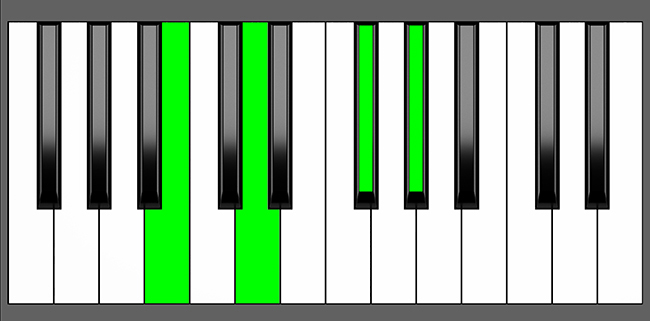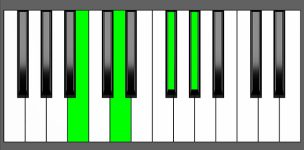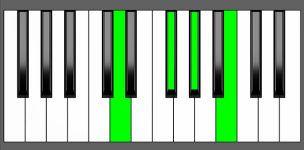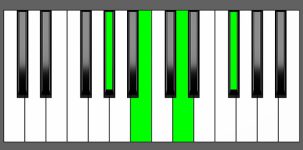Piano Diagram of Bm6 in Root Position

The Bm6 is a chord made up of four notes B, D, F#, and G#. It’s the minor chord built on the key of B with an added major 6th interval (G#). It belongs to the chord family of “added tone chords” (aka “add chord”) because it has an extra tone added to a minor triad. In this article, we’ll take a closer look at the music theory behind this chord.
Structure of Bm6
Notes |
|---|
| B, D, F#, G# |
Intervals |
|---|
| R, m3, 5, 6 |
Finger Position
Left Hand |
|---|
| 5, 3, 2, 1
5, 4, 2, 1 |
Right Hand |
|---|
| 1, 2, 4, 5
1, 2, 3, 4 |
Bm6 Chord Inversions
The Bm6 chord has a total of 3 inversions:
| Root Position: | B | D | F# | G# |
| 1st Inversion: | D | F# | G# | B |
| 2nd Inversion: | F# | G# | B | D |
| 3rd Inversion: | G# | B | D | F# |
Piano Keyboard Diagrams
Bm6 Chord Equivalencies
Rearranging the notes of a chord can lead to interesting and unique chord equivalencies. This is especially true for 6th chords, as we can create a different type of chord by rearranging the notes of a minor 6th chord in a specific way.
If we take the 3rd inversion of a minor 6th chord, where the 6th note becomes the root note, we end up with a minor 7th flat 5th chord (also known as a half-diminished chord).
For example, let’s take the Bm6 chord, which consists of the notes B, D, F#, and G#. By rearranging the notes so that G# becomes the root note, we get a G#m7b5 chord with the notes G#, B, D, and F#.
3rd Inversion of Bm6 = G#m7b5
The reason why the 3rd inversion of a minor 6th chord results in a minor 7th flat 5th chord is due to the note relationships between the chords. When we move the 6th note to become the root note, we end up with a chord that has a minor 3rd, diminished 5th, and a minor 7th interval. These intervals are exactly the same as a m7b5 chord.
Also, note that the 3rd inversion of a minor 6th chord is a dominant 9th chord without root. In fact, Bm6 3rd inversion is G#, B, D, F# which could be considered also an E9 (E, G#, B, D, F#) without the root.
Music Theory and Harmony of Bm6
A B minor 6th chord consists of four notes, a B minor triad, plus a 6th interval. Due to the inclusion of the major sixth interval, represented by the note G#, the B minor 6th chord generates a sense of tension that can either be resolved by transitioning to a more stable chord or utilized to create a feeling of “uncertain stability.”
Building the Bm6 Chord: Different Approaches
Starting from the B Major Scale
To build a minor 6th chord, you would include the root note, minor third, fifth, and sixth from a minor scale.
However, when teaching this concept, it can be more effective to demonstrate its construction using a major scale. This is because a major scale better illustrates the relationship between intervals and their respective qualities.
For instance, to build the Bm6 chord, you can start with the B Major scale:


To create a Bm6 chord, apply the formula R, m3, 5, 6 in the following manner:
- Begin with the Root note, B.
- Select the 3rd interval D# then lower it down by a half-tone to get the minor 3rd, D.
- Include the 5th note, which is F#, to the chord.
- Finally, add the 6th interval, G#.
By following this simple formula, you can create a minor 6th chord from any major scale.
by Combining Intervals
One method to create a minor 6th chord is by combining specific intervals – a minor 3rd, a major 3rd, and a major 2nd (a whole-tone).
m3 + 3 + 2 = minor 6th Chords
To illustrate, let’s use the Bm6 chord as an example: by examining the intervals between the notes, we can see that
- B-D is a minor 3rd interval,
- D-F# is a major 3rd interval,
- and F#-G# is a whole-tone interval.
These three intervals can be stacked together to create the Bm6 chord.
How to Use Bm6 in a Chord Progression
A minor 6th chords can be used as a variation of a minor chords. However, it’s important to understand that the major 6th interval present in this chord may not always be a part of the scale being used.
on Natural minor Scales
| Minor Scales | i | ii | III | iv | v | VI | VII |
|---|---|---|---|---|---|---|---|
| B | B min7 ⇒ Bm6 | C#m7b5 | D Maj7 | E min7 | F# min7 | G Maj7 | A7 |
| F# | F# min7 | G#m7b5 | A Maj7 | B min7 ⇒ Bm6 | C# min7 | D Maj7 | E7 |
| E | E min7 | F#m7b5 | G Maj7 | A min7 | B min7 ⇒ Bm6 | C Maj7 | D7 |
- Non-diatonic Tonic chord in B minor
- Subdominant chord in F# minor
- Non-diatonic Dominant chord in E minor
on Major Scales
| Major Scales | I | ii | iii | IV | V | vi | vii |
|---|---|---|---|---|---|---|---|
| A | A Maj7 | B min7 ⇒ Bm6 | C# min7 | D Maj7 | E7 | F# min7 | G#m7b5 |
| G | G Maj7 | A min7 | B min7 ⇒ Bm6 | C Maj7 | D7 | E min7 | F#m7b5 |
| D | D Maj7 | E min7 | F# min7 | G Maj7 | A7 | B min7 ⇒ Bm6 | C#m7b5 |
- Supertonic chord in A Major
- Non-diatonic Mediant chord in G Major
- Non-diatonic Submediant chord in D Major
Non-diatonic positions
In the case of the B minor 6th chord, the G# does not exist in either the B natural minor scale or the D major scale. This is why the B minor 6th chord (and any other chords with non-scale tones) are called “non-diatonic.”
As a result, it is possible that the inclusion of this chord could cause dissonance within a melody or harmonic progression. So, just be careful when you use this chord in your music. Make sure it works well with the other chords and notes so that it makes the whole piece sound better.
Bm6 Function in Major and Minor Keys
Understanding Scale Degrees
Scale degrees are essential for understanding the relationship between the notes in a scale and how they function within chords. The diatonic major scale consists of seven degrees, each with its unique role in creating the overall harmony of the scale.
- The first degree of the scale is known as the Tonic, which serves as the anchor for the music. It establishes a stable tonal center that acts as the foundation for the scale.
- The second degree is called the Supertonic, often used as a transitional note between the Tonic and other notes in the scale. It creates a sense of motion within the melody or harmony.
- The third degree of the scale is the Mediant, which sits halfway between the Tonic and Dominant notes. It helps establish whether the scale is major or minor.
- The fourth degree is called the Subdominant, used to complement the Dominant and add tension and resolution to the music.
- The fifth degree is the Dominant, which creates tension and anticipation within the melody or harmony, typically resolved by returning to the Tonic.
- The sixth degree is the Submediant, often employed as a transitional note between the Dominant and Tonic, adding a sense of stability and restfulness to the music.
- The seventh degree is the Leading tone, located one half-step below the Tonic. It creates a strong sense of tension and a desire to resolve to the Tonic, frequently used to create a sense of resolution and finality in the melody or harmony.
Bm6 in B minor (Non-Diatonic)
The B minor 6th chord is a unique and intriguing option as the tonic chord in the B natural minor scale, as it creates a complex and ambiguous harmonic center. The presence of the major 6th interval (G#) adds tension and dissonance to the chord, creating a sense of instability and uncertainty.
However, since G# is not included in the scale, the Bm6 may clash with the melody, bass line, or other elements of the music. This dissonance can be used to create a sense of tension, but it can also make the chord difficult to use in certain musical contexts.
Non-diatonic chords, as the Bm6 in this case, can be used to modulate between keys or to add harmonic color and contrast to a composition. It can be used as part of a chromatic modulation to move to a related key or to create a sense of chromaticism within the natural minor scale.
| i | ii | III | iv | v | VI | VII |
| B min7 ⇒ Bm6 | C#m7b5 | D Maj7 | E min7 | F# min7 | G Maj7 | A7 |
Bm6 Chord Progressions as i degree
The following chord progressions are examples of how the B minor 6th chord can serve as the tonic chord (i degree). I’ve added a possible voicing but it’s just a suggestion.
i VI VII III
| i | VI | VII | III |
| Bm6
(B, D, F#, G#) |
G Maj7
(B, D, F#, G) |
A7
(A, C#, E, G) |
D Maj7
(A, C#, D, F#) |
Chromatic modulation
| i | iΔ | i7 | i6 |
| B min
(B, D, F#, B) |
B min(Maj7)
(B, D, F#, A#) |
B min7
(B, D, F#, A) |
Bm6
(B, D, F#, G#) |
i iv VI VII
| i | iv | VI | VII |
| B min7 | Bm6
B (D, F#, A) | B (D, F#, G#)* |
E min7
(B, D, E, G) |
G Maj7
(G, B, D, F#) |
A7
(G, A, C#, E) |
(*Play the root note with your left hand and the notes within the brackets with your right hand.)
Bm6 in F# minor
The B minor 6th can also appear as the subdominant chord in the key of F# minor.
| i | ii | III | iv | v | VI | VII |
| F# min7 | G#m7b5 | A Maj7 | B min7 ⇒ Bm6 | C# min7 | D Maj7 | E7 |
Bm6 Chord Progressions as iv degree
The following chord progressions feature a Bm6 chord as the subdominant (iv degree):
iv III VI VII
| iv | III | VI | VII |
| Bm9 | Bm6
B (D, F#, A, C#) | B (D, F#, G#, B) |
A Maj7 | D Maj7 | E7 |
i iv VI v
| i | iv | VI | v |
| F# min7 | Bm6 | Bm7 | D Maj7 | C# min7 |
Bm6 in E minor (Non-Diatonic)
The Bm6 chord can also function as a variation of the dominant chord in the E natural minor scale. When used as a dominant minor chord in a minor key, the Bm6 creates a tense and unresolved sound that conveys a feeling of instability and urgency.
This chord generates a sense of anticipation and tension in the music as if it is leading somewhere and needs to resolve to the tonic chord (E min) to provide a sense of closure.
In this way, the dominant minor chord acts as a musical bridge that connects the other chords in the progression to the tonic. It contrasts with the tonic chord by creating tension and movement, while the tonic chord represents stability and resolution.
| i | ii | III | iv | v | VI | VII |
| E min7 | F#m7b5 | G Maj7 | A min7 | B min7 ⇒ Bm6 | C Maj7 | D7 |
Bm6 as v degree – Chord Progressions
If you want to hear how the B minor 6th chord sounds as the dominant (V) chord in the E natural minor scale, try playing the following chord progressions. However, it may sound slightly dissonant due to the absence of the 6th (G#) in the E minor scale. Nevertheless, the Bm6 chord could be an option for creating certain musical effects.
i iv VI v
| i | iv | VI | v |
| E min7 | A min7 | C Maj7 | Bm7 | Bm6 |
i v VI VII
| i | v | VI | VII |
| E min7 | Bm7 | Bm6 | C Maj7 | D7 |
i VI v iv
| i | VI | v | iv |
| E min7 | C Maj7 | Bm7 | Bm6 | A min7 |
Bm6 in A Major
Besides its use in natural minor scales, the Bm6 chord can also be played in major keys. In the key of A major, for instance, the Bm6 chord functions as the supertonic chord, located on the second degree of the scale.
A supertonic minor 6th chord in a major key produces a slightly tense and unresolved sound, creating a feeling of anticipation or expectation as it typically leads to the dominant or subdominant chords.
| I | ii | iii | IV | V | vi | vii |
| A Maj7 | B min7 ⇒ Bm6 | C# min7 | D Maj7 | E7 | F# min7 | G#m7b5 |
Bm6 Chord Progressions as ii degree
Try playing the following chord progressions to better understand how the Bm6 chord functions as the supertonic (ii) chord in the key of A major.
ii V I
| ii | V | I |
| B min6 | E7 | A Maj7 |
I IV ii V iii vi ii V
| I | IV | ii | V | iii | vi | ii | V |
| A Maj7 | D Maj7 | Bm6 | Bm7 | E7 | C# min7 | F# min7 | B min7 | E7 |
Bm6 in G Major (Non-Diatonic)
In addition to its positions in natural minor scales and major keys, the Bm6 chord can also function as the mediant (iii) chord in the key of G major, located on the third degree of the scale.
The mediant minor chord creates a temporary tonal ambiguity or departure from the established tonality of the key before returning to the tonic chord.
| I | ii | iii | IV | V | vi | vii |
| G Maj7 | A min7 | B min7 ⇒ Bm6 | C Maj7 | D7 | E min7 | F#m7b5 |
Bm6 Chord Progressions as iii degree
To better understand how the Bm6 serves as the mediant (iii) in the G major scale, you can try playing the following chord progressions.
I iii IV V
| I | iii | IV | V |
| G Maj7 | B min7 | B min6 | C Maj7 | D7 |
I iii ii V
| I | iii | ii | V |
| G Maj7 | B min7 | B min6 | A min7 | D7 |
I iii vi V
| I | iii | vi | IV |
| G Maj7 | B min7 | B min6 | E min7 | C Maj7 |
Bm6 in D Major (Non-Diatonic)
The Bm6 chord can be played on the sixth degree of the D major scale, functioning as the submediant chord. The submediant chord is typically characterized by a feeling of relaxation and stability in a chord progression.
However, when the chord is formed using a major 6th interval, it can create a sense of uncertainty or ambiguity. This can add an interesting twist to the otherwise stable and calming effect of the submediant chord.
| I | ii | iii | IV | V | vi | vii |
| D Maj7 | E min7 | F# min7 | G Maj7 | A7 | B min7 ⇒ Bm6 | C#m7b5 |
Bm6 as vi degree – Chord Progressions
You can explore the sound of Bm6 as the submediant chord in the key of D major by playing the following chord progressions:
I iii vi V
| I | iii | vi | V |
| D Maj7 | F# min7 | B min7 | B min6 | A7 |
I vi ii V
| I | vi | ii | V |
| D Maj7 | B min6 | E min7 | A7 |
I IV ii V iii vi ii V
| I | IV | ii | V | iii | vi | ii | V |
| D Maj7 | G Maj7 | E min7 | A7 | F# min7 | B min6 | E min7 | A7 |
Alternative Nomenclature for Bm6
- B -6
- Si -6
- Si m6
- B m6th
- B min6
- Si min6
- B m(add6)
- B min add 6
- B minor 6th
- B minor sixth
Conclusion
The chord progressions and examples presented in this post provide a comprehensive overview of the most common uses of the B min6 chord. It’s important to note, however, that many advanced harmony-related topics could not be included due to space constraints. These topics include chord progressions built on harmonic and melodic scales, modal scales, hidden tonality, secondary dominants and other chord substitutions, non-functional harmony and atonal music, modal interchange and borrowed chords, voice leading and counterpoint, chromatisms, jazz harmony…I mean, music theory is a huge topic!
Although I couldn’t cover all of these topics in my post, I encourage readers to continue exploring these areas in their study and research. By expanding your knowledge in these advanced areas of music theory, you can gain a deeper understanding of the harmonic possibilities that exist beyond the basics presented here.



